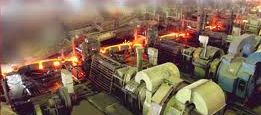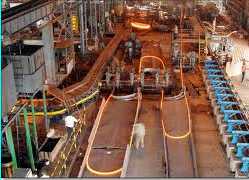Differences Between Hot Rolled Steel and Cold Rolled Steel, But What ALLOY IS IT?
Last Updated: March 22, 2024

Home
Metalworking
How I Store My Stock
Figuring Weights of Steel
Contact Us
The Hot Rolled Steel versus Cold Rolled Steel Question:
Here’s an email that I received recently. It asks a pretty common question:
"Hello Pete, need some help understanding the difference between hot
roll and cold roll steel, and the reasoning for the preference for one
over the other???? Can you please answer this question?????"
Basic differeneces between hot rolled steel and cold rolled steel
Theoretically, the only difference between hot rolled and cold rolled steels is that hot rolled steel is rolled to its
final dimensions while hot enough to scale (over about 1700 degrees F) while cold rolled steel is rolled to its final dimensions
well below scaling temperatures.
So----- If you are making ½” square HOT rolled steel, you have to estimate what the final size will be after the product
cools, whereas you can finish the Cold rolled steel to much closer tolerances right in the sizing rollers and that is what
you get.
Rolled versus Drawn
A while back in time, I received an email offering the following:
"Every cold finish BAR (as opposed to SHEET) mill I have ever been in DRAWS the bar through correctly sized DIES, not ROLLERS.
That is why it is called Cold Drawn Steel, not Cold Rolled Steel unless you are talking about Cold Rolled Sheet Steel which is rolled, not drawn.
Cold finish bars can be drawn, turned or ground and polished but they are not rolled."
But, for the rest of this article, I won't differentiate between die drawing and rolling. I don't doubt what the gentleman has to say,
because I have never been in a cold finish bar mill, but I do know that at least some HOT finish bar mills do use rollers.
There are some other things to consider, too:
Tolerances and Finish differences between hot rolled steel and cold rolled steel
-The finished tolerances on hot rolled steels are looser than on cold rolled. Not only the plus or minus tolerance from
nominal size, but the "square-ness" of the product. And, I can tell you from personal experience that there’s a lot of
trapezoidal (HOT rolled) A36 out there. So, if you need a specific size and you are going to go to a “surplus” place, bring your ruler,
square and micrometer to make sure you get what you need.
- I have been told that, in order to get the cold rolled steel to come out with a nice finish, they might use "cleaner"
ingots from which to roll the product. This means that you’d get fewer slag or carbon inclusions with cold rolled
steels.
!!!But all this Tells you NOTHING About WHAT ALLOY of STEEL IT IS!!!!
Click Here to see Why it is often hard the get Alloy information on steels
-Note that I haven't talked about the chemistry of the steel at all. You can get cold rolled or hot rolled 1045 and you
can perform either process on C1018. But since we often talk about using "mild" steels, the two steels that we end up
having around most often are C1018----which is quite often sold in cold rolled form and A36 which is always hot
rolled.
-One other difference that may be of interest to the blacksmith is that if you buy "1018”cold rolled steel", you
can be pretty sure that it has close to a 0.18% carbon content and few other impurities. But the spec for A36 can
let the carbon content go as high as 0.29% and
it can contain many more impurities. More carbon makes it harder to forge.
-Recently I heard that the manufactures of hot rolled/drawn steel have been asking ASTM to loosen the specs on A36 even more. I guess since
they are using more and more scrap steel in the process, more carbon and more of other alloys keep creeping in to the mix.

Costs and Machining of hot rolled and cold rolled steels
-You generally have to pay about twice as much money for cold rolled steel as for hot rolled steel, for reasons which
are probably obvious from the above.
So far, you are probably feeling that, in dealing with mild steels, cold rolled steel is clearly the better stuff to
have if you can afford it. Well, yes, usually, but---- since the hot rolled steel IS rolled while hot, it has a
chance to normalize after the last rollers,
so it is pretty much stress free when you get it. But machinists who usually buy cold rolled steel, often have the
stuff twist and warp on them as they machine the first side or two. This is because the cold rolled steel actually
work-hardens in the rolling process.
For blacksmiths, this isn't much of a problem, since we are usually going to heat it up and reform it anyway.
There is also an in-between finishing hot rolling process called "P & O" (Pickled and Oiled). In this case, the hot
rolled steel is pickled in acid to remove the mill scale and then oiled to keep it from rusting. The cost is somewhere
in between that of regular hot rolled and cold rolled.
Final notes about hot rolled steel and cold rolled steel usage
Finally, in my experience, the more popular (to the steel yard) sizes of mild steel usually come in both cold and
hot rolled. I buy hot rolled whenever I can for blacksmithing. Except if I'm going to put a LOT of work into
a piece. Then I buy cold rolled steel to minimize the possibility of having a crack appear in the shaft of
my fancy flesh fork after about an hour of forging and an hour of filing and chasing. But in some sizes,
for instance 1/4" square, the steel yards in our area only carry it in cold rolled, at twice the price
of hot rolled---- so if I want any of that for S-hooks and for nails, etc., I'm stuck with the higher
priced stuff--- unless I want to order a ton or two to get it in hot rolled form!
More links to metalworking topics on this website, mostly related to hot rolled steel
How To Get Started Blacksmithing
Annealing In The Ash Bucket
Electrolytic Derusting


